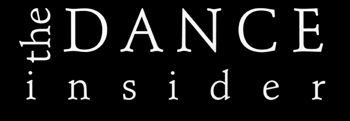







Go
back to Flash Reviews Flash Review 1, 10-9: "V" is for...New
Mark Morris! By Aimee Ts’ao BERKELEY -- When I arrived at Berkeley's Zellerbach Hall Thursday to see the preview of Mark Morris's latest choreography, "V," (see Flash Interview, 10-2) I could still savor the lingering tastes and aromas from the previous night's seven-course epicurean feast presented by Cal Performances, Morris's "Platee." I had been so drunkenly satiated by his production of the Rameau opera that I dreaded being let down by the choreographic buffet about to be served. The appetizer and soup sufficed. The opening "Dancing Honeymoon" was Paul Taylor lite. A cheerful romp, to music recorded by Gertrude Lawrence and Jack Buchanan in the 1920s and 30s and arranged by Ethan Iverson, it lacked the lurking dark side that Taylor puts into "Company B" and "Black Tuesday." Despite the fluffiness I did enjoy the live music. Then, to Dvorak's lively, and also haunting "Five Bagatelles for String Trio and Harmonium, Op. 47" "The Office" left me wondering many things. Originally set on a folk dance ensemble, it didn't seem to fit with the rest of the program, and yet on re-reading the program notes (its first performance occurred during the third year of the siege of Sarajevo) and in light of the events of September 11, it made sense. Six people -- sitting on chairs, moving about, talking and dancing together -- disappear one by one as a man in a suit emerges from the wings with a clipboard and summons them to go, until one woman is left alone. It didn't matter that the choreographic vocabulary was folk dance, I felt deeply saddened by the inevitability of loss and the our inability to explain or prevent it. Then an intermission to clear the palette. On to the main course (I almost said "meat" of the program, but being a vegetarian...)Morris set "V" to Robert Schumann's Quintet in E-flat Major for Piano and Strings, Op. 44, a piece I was obsessed with several years ago and listened to ad infinitum. I worried that my extreme familiarity with the music might create extra biases on my part. As a dancer I often imagine how I would move to certain compositions, not really choreographing, but mentally experimenting with movement textures. And I was apprehensive because the last few of Morris's pieces ("Sandpaper Ballet," "A Garden," and "Four Saints in Three Acts)" I found disappointing -- not bad, but less than I felt he was capable of. Watching dance as a critic, as opposed to a dancer or normal person, is made difficult by several factors. One is trying to write quickly in the dark, and another is trying to assess the work while it's unfolding without having the entire context until it's finished, somewhat akin to attempting a rebuttal in a debate before the opposition has a chance to fully state its argument. When "V" was over and I read my scribblings I realized that my criticisms were made mostly before the grander scheme became visible and with hindsight I found myself eating those words (they would have tasted better with a Zabaglione sauce). I wish I had been able to see it again and enjoy the piece without having my critic's voice talking in my ear. Not one to describe in great detail the actual steps, I prefer to say that the first movement, Allegro brilliante; in modo d'una Marcia, starts slowly and simply. The seven dancers in vivid blue costumes stand in a "V" on stage and move in lines. This is followed by small groups of two, three and four adding new choreographic material as they emerge and retreat or disburse themselves across the stage. Then the whole section is repeated by the other half of the cast, dressed in pale celadon green. Finally, both groups execute the section sharing the space with thrilling precision as the patterns overlap in a way I imagine having extreme double vision would look. (The displacement between the two images being very wide.) For the next movement, Un poco largamente - Agitato, one couple begins crawling in a circle around each other. One line of dancers perpendicular to the footlights crawls across the stage while another parallel to them intersects and passes through it while upright . Later variations of this reappear switching and mixing up the directions, the colors of the costumes, the crawling and walking. I admit that I thought the crawling went on too long, though with variation in the steps it could have been quite intriguing. I was reminded of an M.C. Escher image where the dark crouching simian man circles around to shake hands with the smiling white human. This section was also interspersed with some very tender and inspired partnering. The Scherzo molto vivace consisted again of fascinating floor patterns, often overlapping each other. As the pace picked up the dancers abandoned themselves to the movement and the piece became like a bird swooping close to the ground on the verge of rising into the sky. By the last movement, Allegro, ma non troppo, the energy, the momentum, the sheer joy of the dancers positively soared. Curiously, the more balletic the choreography became, the better the dancing looked. My companion remarked that he could see every note of the music on stage, and I would add that Morris captured the overarching structure of the composition as well. However, it was the feeling of togetherness, of a common spirit amidst all the final choreographic complexity that ultimately left me dizzy with feelings of je-ne-sais-quoi. One of the feelings is definitely of gratitude for this gift of light in these days of darkness. |
|||||||



